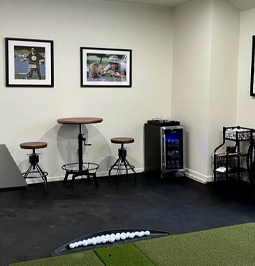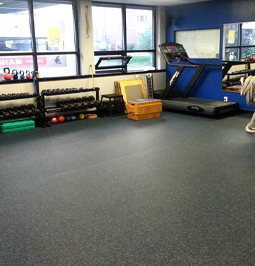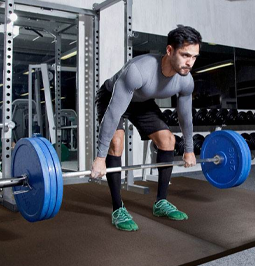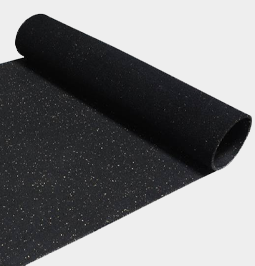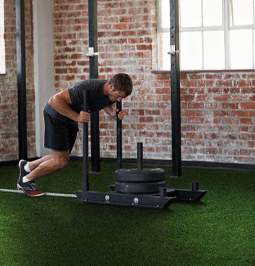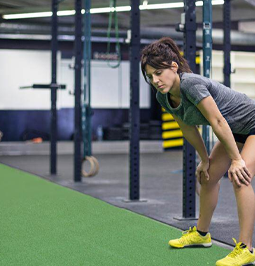Commercial Gym Flooring: Everything Rubber and Gym Turf
There’s no better feeling than opening the fitness studio you’ve dreamed of or finishing a much-needed gym remodel. An essential part of your project is choosing versatile commercial gym flooring to protect your athletes’ joints and your subfloor from rigorous routines.
We’ve got a variety of commercial fitness flooring, including rubber rolls, rubber tiles, and gym turf. Explore the pros and cons of each, thickness and installation options, and our top recommendations.
We’ve got a variety of commercial fitness flooring, including rubber rolls, rubber tiles, and gym turf. Explore the pros and cons of each, thickness and installation options, and our top recommendations.
About Commercial Gym Rubber Flooring
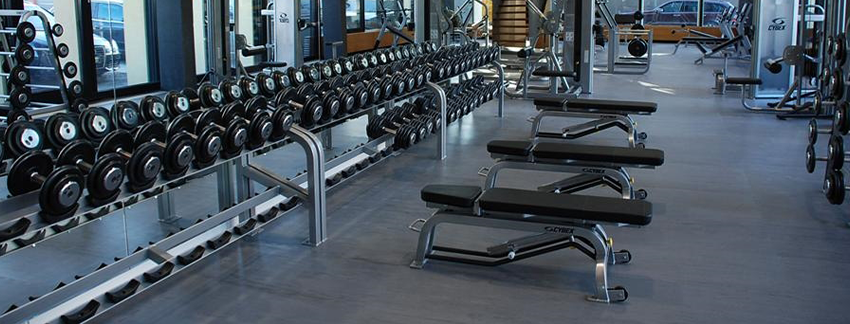
This is the most common choice in commercial fitness centers. Fitness enthusiasts and gym owners alike love it for the variety of sizes and thicknesses, water resistance, extreme durability, and slip-resistant surface underfoot.
Rubber workout flooring comes in rolls, tiles, and mats – great for different workout intensities, install needs, and budgets.
Commercial Rubber Flooring Thicknesses
Regardless of the type of rubber flooring you choose, it’s essential to get the correct thickness for your intended use. If you choose material that’s too thin for your fitness needs, the lifetime of your floor may be shorter.Recommended Thicknesses
- 8mm: The bare minimum we recommend for a commercial setting.
- 3/8": Our most popular choice for commercial gyms.
- 1/2”- 3/4”: Ultra-thick rubber flooring to protect your subfloor from the impact of your heaviest dumbbells.
- 1” +: Olympic-rated flooring for heavy lifting that can withstand dropped weights.
How to Install Commercial Gym Rubber Flooring
Explore the most popular installation options.- Loose-lay: Rubber is naturally heavy enough to stay in place with no additional adhesive. If you loose lay your rubber rolls or tiles, you can pick
- Double-sided tape: For a more secure install, consider using double-sided carpet tape around the perimeter of your rubber floor. If needed, you can remove your floor and transport it to another location.
- Glue-down: In extreme conditions, CrossFit® and commercial gym owners prefer to glue down their rubber gym flooring to ensure no movement or curling up at the edges of the floor. As it’s a permanent solution, once you glue down your rolls, you can not reuse them elsewhere. Note: Recommended for rubber rolls only, as a seamless installation with rubber tiles is challenging. Also, once you glue down your rolls, you can not reuse them elsewhere.
Commercial Gym Rubber Flooring Rolls
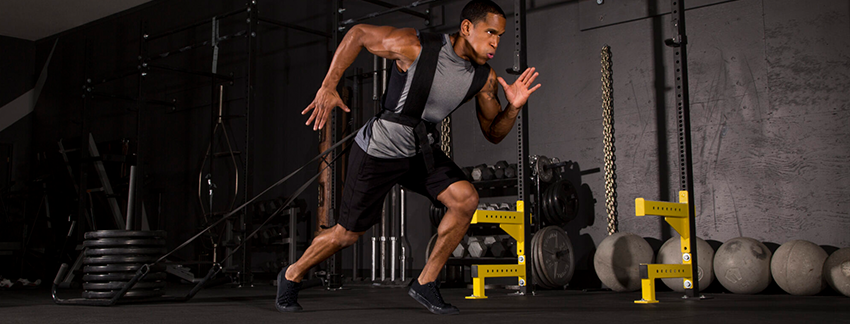
Rubber rolls are a staple in just about every traditional gym out there. They’re the premier commercial gym flooring for sharp, sleek looks, extreme durability, and shock absorption. We offer various thicknesses for different workout needs, including high-impact, plyometric movements.
Pros of Rubber Flooring Rolls
- Ultra-durable: Thick rubber material in commercial gyms can last for years.
- Simple installation in large spaces: Easily cover a large surface area with a couple of rubber rolls.
- Easy to clean material: Simply vacuum or use a damp mop when necessary.
- Environmentally responsible: Many of our rubber flooring rolls are made from recycled rubber manufactured in the USA. For safety-tested options, explore our selection of FloorScore® Certified rubber flooring.
- Virtually seamless appearance: When rolls are correctly aligned, the seams of the floor are almost undetectable. The seamless appearance helps provide an extremely polished look.
- Sound and shock absorbing: Rubber rolls absorb shock underfoot and sound from dropped heavyweights and equipment – perfect for high-traffic commercial gyms.
- Anti-microbial: Rubber material is water-resistant and won’t trap bacteria in your rubber floors or beneath.
Cons of Rubber Flooring Rolls
- Weight: Rubber flooring rolls have substantial weight, so if installing on your own, you may need additional help.
Commercial Gym Rubber Floor Tiles

Rubber tiles are durable, affordable, and known for their easy, DIY, interlocking installation. Although they’re most well known as the premier home gym flooring solution, many gym owners love using rubber tiles as commercial gym flooring.
Pros of Rubber Tiles
- Easy DIY installation: The most significant appeal for tiles over rolls is that they come together just like puzzle pieces, which you can loose lay without adhesives.
- Lighter than rubber rolls: You can quickly move your tiles piece by piece.
- Environmentally responsible: We offer a wide variety of rubber floor tiles made from recycled rubber and manufactured here in the USA.
- Sound and shock absorbing: For tough workouts and heavy weights, tiles will absorb the shock and sound, keeping your joints and subfloor safe and sound.
- Simple replacement: If you damage one of your tiles, you can replace it with a new one instead of the whole floor.
Cons of Rubber Tiles
- Tedious installation for large spaces: Although rubber gym tiles are easy to install, they get time-consuming in large spaces. They are best for smaller areas.
- Seams: The gaps between the seams of rubber tiles can allow liquids through to the subfloor. Additionally, rubber tiles provide a slightly less seamless appearance than rubber rolls.
- Price: Tiles tend to be more expensive than rolls per square foot.
Commercial Gym Rubber Floor Mats

Rubber gym mats are a fantastic solution for small spaces or dedicated weight rooms. You can choose from thin 1/4" Tough Mats for bodyweight exercises up to 3/4” Shock Mats, which handle the impact of heavy Olympic weightlifting and dumbbell exercises.
Installation is simple, too. Lay the rubber mat down where you want, and you’re done. In extreme conditions, use double-sided carpet tape around the perimeter of your mat to ensure it stays perfectly in place.
Pros of Rubber Floor Mats
- Great for small spaces: When you don’t need to cover an entire area, rubber weight mats will be your best option, saving you time and money.
- Traction and shock absorption: Rubber mats provide the necessary traction and comfort your athletes look for. Rubber’s naturally shock-absorbent material reduces the impact on their bones and muscles during cardio, weight lifting, and more.
- Noise reduction: Rubber gym mats dampen the vibrations that come from vigorous exercise, also helping to protect the shock to your subfloor.
- Portable: No installation is necessary with gym floor mats. You can easily change your setup by simply picking the mats up and moving them.
Cons of Rubber Floor Mats
- Not appropriate for large spaces: We recommend rubber rolls to save money and installation time if you have a large area to cover.
- Price: Rubber gym floor mats are affordable on their own, but they are more expensive per square foot.
Top Recommendations
About Commercial Gym Turf
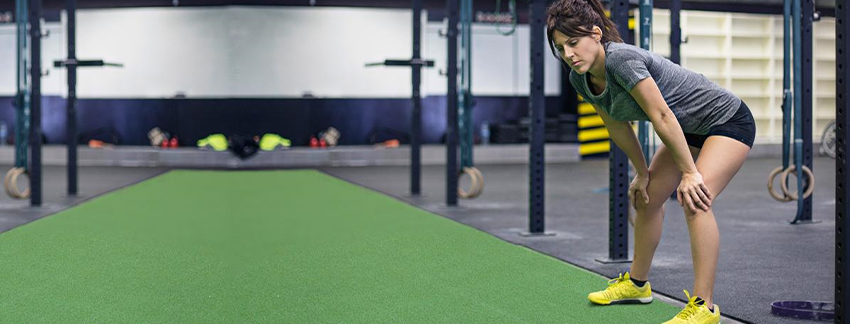
From strength training and conditioning to yoga and stretching, your athletes can reach their full workout potential with safe, resilient gym turf. Gym turf provides a flat, cushioned surface great for pulling or pushing sleds, CrossFit®, or performing HIIT® workouts.
Commercial Gym Turf Material
Your turf floor can withstand the substantial weight of equipment and aggressive workout routines over long periods. Check out three of the most popular materials for a commercial gym.Recommended Materials
- Polypropylene: This is one of the softest turf materials and is less likely to irritate your hands and elbows during floor exercises.
- Polyethylene: Great for indoor and outdoor use. It’s ultra-durable and UV-resistant, therefore won’t deteriorate in the sun.
- Nylon: Nylon is our most durable turf material, perfect for fitness facilities. It works well for various fitness circuits and is substantial for consistent sled work. Note: Nylon is not UV-stable and should not be used for outdoor gyms.
How to Install Commercial Gym Turf
Below are three of the best ways to install your indoor gym turf.- Loose-lay: The easiest way to install gym turf tiles is to lay them directly on your floor; no glue or tape is needed. Note: Not recommended for rolls, as they can shift more easily.
- Double-sided tape: Simply use double-sided tape around the perimeter of your turf tiles and rolls to keep them in place.
- Glue-down: For commercial gyms, we recommend gluing down your turf rolls to ensure they stay in place. However, you cannot reuse them if you move locations. Note: Best for gym turf rolls. If you glue too close to the seams of your rubber tiles, they can seep through and leave a less seamless appearance.
Commercial Gym Turf Rolls
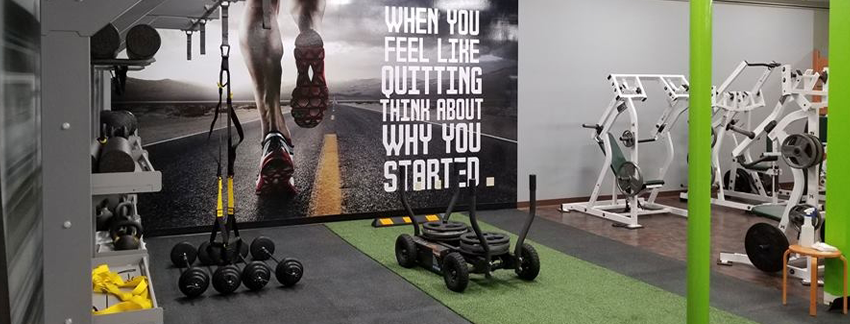
Work on your strength and ability with impact-resistant gym turf rolls. They’re excellent for creating lanes across your space for those who enjoy a soft, natural grass feel for yoga, stretches, and pushing and pulling sleds.
Pros of Gym Turf Rolls
- Versatile: An excellent gym flooring option for running, calisthenics, CrossFit®, and more.
- Durability: Turf can withstand plenty of wear and tear while still looking fantastic all year long.
- Low maintenance: Save costs and time with the little upkeep needed for your gym turf.
- Aesthetic: Add a pop of color to your floor. We carry a wide range of vibrant turf colors to complement your gym’s theme.
Cons of Gym Turf Rolls
- Little subfloor protection: While some artificial turf options come with an added layer of protection, many require using an underlayment to protect your subfloor if you plan to drop heavy weights.
- Abrasive material: Depending on the material you choose, turf isn’t the most comfortable for floor exercises, like burpees and sit-ups. Note: Nylon turf material tends to be harsher. Therefore, we recommend it mainly pushing and pulling sleds.
- Challenging to install: Turf rolls are heavier and more challenging to work with than tiles.
Top Recommendations
Commercial Gym Turf Tiles
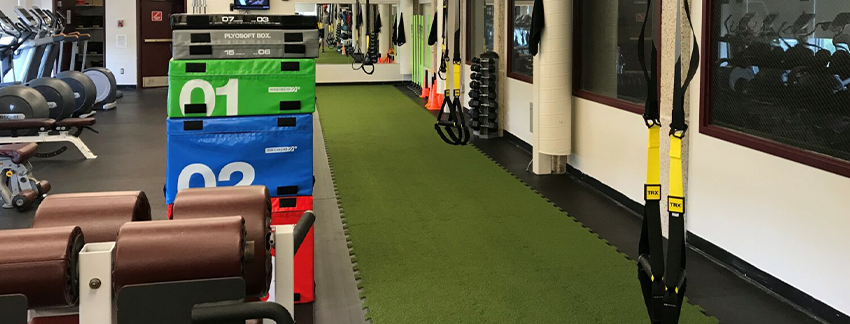
Gym turf tiles are an excellent choice to cover smaller or odd-shaped areas of your commercial gym. Gym owners love how versatile they are for running, calisthenics, CrossFit®, and more.
In terms of quality and performance, gym turf tiles are equivalent to gym turf rolls. One thing to consider is that they tend to be more expensive than turf rolls, so gym owners often use them for dedicated areas around the gym.
Pros of Gym Turf Tiles
- Great for oddly shaped spaces: You can easily cut turf tiles to fit any space.
- Interlocking installation: These interlocking tiles connect just like puzzle pieces.
- Durability: Gym turf can withstand plenty of wear and tear, even against pushing and pulling heavy sleds on them.
- Appearance: Adding artificial grass can create a more lively feel to your commercial gym.
Cons of Gym Turf Tiles
- Little subfloor protection: While most sports turf tiles have an attached rubber backing, some don’t. We recommend checking with your manufacturer, and if your tiles don’t have it, placing underlayment underneath to protect your subfloor.
- Abrasive material: The turf texture isn’t always ideal for exercises like burpees and sit-ups, as it can be more uncomfortable under bare hands. Note: Nylon turf material tends to be harsher. Therefore, we recommend it mainly pushing and pulling sleds.
- Price: Turf tiles tend to be more expensive than commercial gym flooring.
Commercial Gym Flooring FAQ

Here are our most frequently asked questions and answers about commercial gym flooring.
What’s the best flooring for commercial gyms?
Rubber flooring and gym turf are the best options for a commercial gym setting. They’re highly durable, shock-resistant, and provide a stable, even surface for safer workouts.Most gyms have both throughout the space to offer a unique feel and experience for different exercises. By far, our most popular commercial gym rubber flooring thickness is 3/8”, and for gym turf, 3/4” thick.
How thick should commercial rubber gym flooring be?
There is a common misconception that commercial gyms require the thickest rubber gym flooring possible. Most commercial and even CrossFit® gyms do well with the 3/8” rubber.For dumbbell areas of the gym, most commercial gyms owners chose 1” + rubber gym tiles. As the impact of dropped weights decreases the floor’s support over time, you can easily replace your rubber tiles when needed without removing your entire floor. Note: Replacing your rubber tiles will be more challenging if you glue them down
How do you clean commercial gym flooring?
Rubber Flooring Cleaning Tips
Each product offers specific instructions on cleaning and maintenance. For most commercial gym flooring options, you can sweep regularly and occasionally damp mop with a simple cleaning solution of mild soap and water.Gym Turf Cleaning Tips
Occasionally sweep your turf to remove loose dirt and debris. For harsher stains, we recommend you lightly scrub down the floor with warm water and household detergent solution and allow it to dry. Note: Never use bleach to clean turf. Also, if your turf becomes matted, you can quickly restore its full appearance by raking it with a synthetic brush.How can I protect my subfloor in a commercial gym setting?
For maximum shock absorption, we recommend selecting our most thick rubber and gym turf flooring. If you’re highly concerned about your subfloor, our variety of underlayments can provide peace of mind and create that extra barrier between your main floor.Are there eco-friendly commercial gym flooring options?
Yes, there is eco-friendly commercial gym flooring. We offer a variety of recycled-rubber flooring made from commercial truck/car tires.Do I need professionals to install my commercial gym flooring?
You can install your commercial gym flooring yourself; however, having a professional install can ensure precision and long-lasting results. We recommend considering your project timeline, the size of your space, and your budget before deciding.Conclusion
Create the commercial gym you feel inspired by with ultra-durable and attractive gym flooring! Shop our full selection of rubber and gym turf options today!



